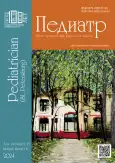Possibilities of using reticulocyte indices for prescribing prevention of early anemia of prematurity
- 作者: Kozarezova A.M.1,2, Klimkovich N.N.1, Krasko O.V.3, Yuraga T.M.1
-
隶属关系:
- Belarusian State Medical University
- Maternity Hospital of Minsk Region
- United Institute of Informatics Problems of the National Academy of Sciences of Belarus
- 期: 卷 15, 编号 6 (2024)
- 页面: 25-32
- 栏目: Original studies
- URL: https://journal-vniispk.ru/pediatr/article/view/312822
- DOI: https://doi.org/10.17816/PED15625-32
- ID: 312822
如何引用文章
详细
BACKGROUND: To date, the literature contains a sufficient number of recommendations for medical care for early anemia of prematurity. But the timing of the beginning of prevention of this disease varies. Therefore, the search of laboratory criteria for the start of drag prevention of anemia of prematurity is very relevant.
AIM: Identify the possibilities of using reticulocyte indices for prescribing drug prevention of early anemia of prematurity.
MATERIALS AND METHODS: A retrospective cohort study included 35 preterm infants. They were divided into two groups. The group 1 consisted of premature infants with early anemia of prematurity which developed before the 30th day of life (n = 16). The group 2 was children with a later manifestation of this disease (n = 19). We were analyzed the parameters of the general blood test with reticulocyte indices and the level of ferritin, transferrin, lactoferrin, erythropoietin in the blood serum at the time of diagnosis of early anemia of prematurity.
RESULTS: Determination of the absolute number of reticulocytes below 110×109/L and the relative number of reticulocytes less than 2.6% on days 8–14 of premature baby’s life determine the drug prevention of early anemia of prematurity in this time period.
CONCLUSIONS: Prescribing drug prophylaxis based on the obtained laboratory parameters will prevent the early onset (before the 30th day of life) of early anemia in premature infants, as well as reduce the frequency and volume of blood sampling.
作者简介
Anna Kozarezova
Belarusian State Medical University; Maternity Hospital of Minsk Region
编辑信件的主要联系方式.
Email: amkneonat@gmail.com
ORCID iD: 0009-0001-9892-8346
SPIN 代码: 2836-5093
Neonatologist, Pediatric Department for Newborns with Perinatal Pathology and Premature Babies
白俄罗斯, Minsk; MinskNatalia Klimkovich
Belarusian State Medical University
Email: det.hematology@mail.ru
ORCID iD: 0000-0001-7645-3952
SPIN 代码: 4223-0421
MD, Dr. Sci. (Medicine), Associate Professor, Head of Department of Pediatric Oncology, Hematology and Immunology Institute, Advanced Training and Retraining of Healthcare Personal of Educational Institute
白俄罗斯, MinskOlga Krasko
United Institute of Informatics Problems of the National Academy of Sciences of Belarus
Email: krasko@newman.bas-net.by
ORCID iD: 0000-0002-4150-282X
SPIN 代码: 7464-8750
Cand. Sci. (Engineering), Associate Professor, Laboratory of Bioinformatics
白俄罗斯, MinskTamara Yuraga
Belarusian State Medical University
Email: 2652441@mail.ru
ORCID iD: 0009-0002-0904-5734
SPIN 代码: 1761-5542
Senior researcher, Department of Metabolic Diagnostics
俄罗斯联邦, Minsk参考
- Balashova EN, Sharafutdinova DR, Narogan MV, et al. Early anemia of preterm infants (guideline). Neonatology: News, Opinions, Training. 2021;9(3):47–61. doi: 10.33029/2308-2402-2021-9-3-47-61 EDN: IPDKYD
- Lazareva VV, Narogan MV, Vedikhina IA, et al. Comparative characteristics of extremely low birth weight children receiving and not receiving folic acid. Neonatology: News, Opinions, Training. 2022;10(4): 8–16. doi: 10.33029/2308-2402-2022-10-4-8-16 EDN: DELPLL
- Rumyantsev AG, Maschan AA, Zhukovskaya EV, editors. Clinical recommendations. Pediatric hematology. Moscow: GEOTAR-Media.; 2015. (In Russ.)
- Sharafutdinova DR, Balashova EN, Kessler YuV, et al. Reticulocyte hemoglobin content as a marker of iron deficiency in premature newborns with very low birth weight. A simple tool for diagnosing iron deficiency. Pediatric Hematology/Oncology and Immunopathology. 2023;22(3):146–155. doi: 10.24287/1726-1708-2023-22-3-146-155 EDN: KNZIAY
- Banerjee J, Asamoah FK, Singhvi D, et al. Haemoglobin level at birth is associated with short term outcomes and mortality in preterm infants. BMC Med. 2015;13:16. doi: 10.1186/s12916-014-0247-6
- Hasanbegovic E, Cengic N, Hasanbegovic S, et al. Evaluation and treatment of anemia in premature infants. Med Arch. 2016;70(6): 408–412. doi: 10.5455/medarh.2016.70.408-412
- Juul SE, Vu PhT, Bryan AC, et al. Effect of high-dose erythropoietin on blood transfusions in extremely low gestational age neonates: post hoc analysis of a randomized clinical trial. JAMA Pediatrics. 2020;174(10):933–943. doi: 10.1001/jamapediatrics.2020.2271
- McCarthy EK, Dempsey EM, Kiely ME. Iron supplementation in preterm and low-birth-weight infants: a systematic review of intervention studies. Nutr Rev. 2019;77(12):865–877. doi: 10.1093/nutrit/nuz051
- Moreno-Fernandez J, Ochoa JJ, Latunde-Dada GO, Diaz-Castro J. Iron deficiency and iron homeostasis in low birth weight preterm infants: a systematic review. Nutrients. 2019;11(5):1090. doi: 10.3390/nu11051090
- Venkatraman ES. A permutation test to compare receiver operating characteristic curves. Biometrics. 2000;56(4):1134–1138. doi: 10.1111/j.0006-341X.2000.01134.x
- Widness JA. Treatment and prevention of neonatal anemia. NeoReviews. 2008;9(11):526–533. doi: 10.1542/neo.9-11-e526
补充文件












